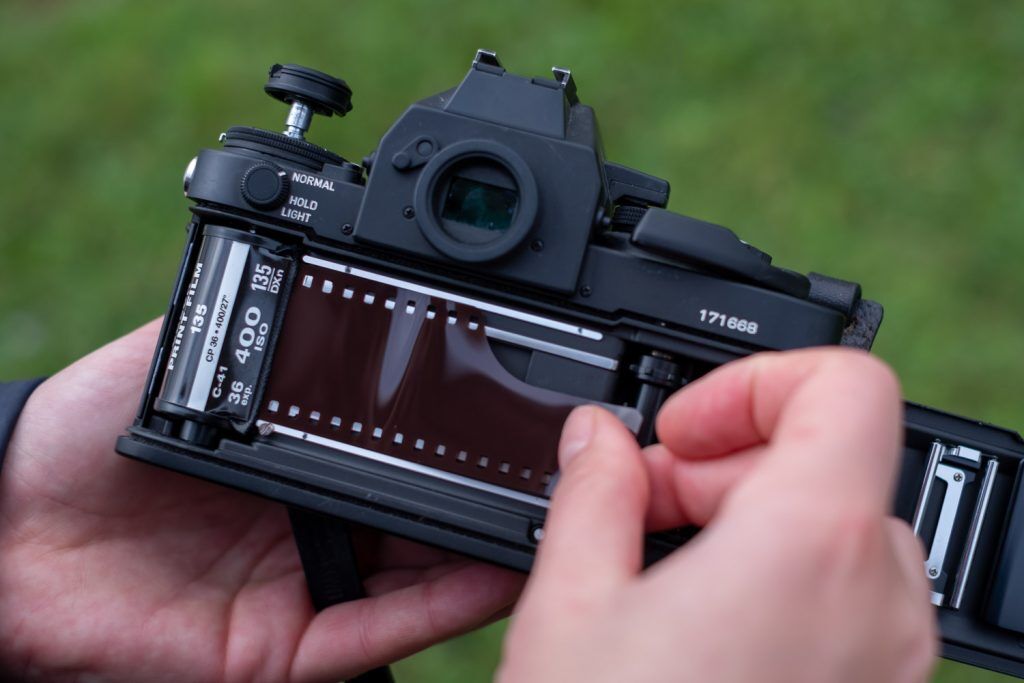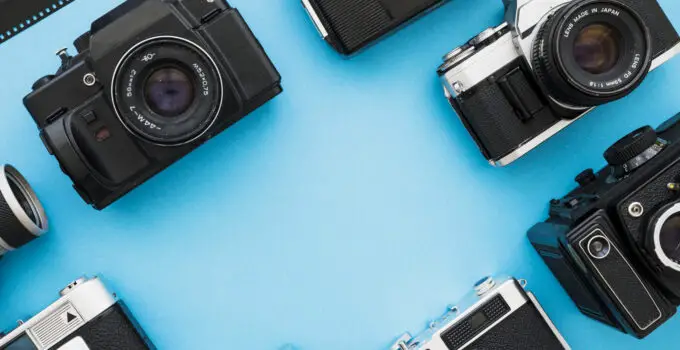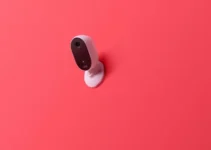How long can film last in a film camera before it goes bad? This is a common question among photographers using traditional film.
Unlike digital images, film is a physical medium that can degrade over time if not properly stored or used. The lifespan of film in a camera depends on several factors, including the type of film, storage conditions, and exposure to light.
While some films may last weeks or even months in a camera, others may start to deteriorate faster. Understanding these factors is crucial for preserving the quality of your photographs.
Here what do you use as a bike camera bag?
How long do film last in a film camera?
The lifespan of film in a camera depends on several factors, including the type of film, storage conditions, and the camera itself. Unused film generally lasts up to two years past its expiration date if stored in a cool, dry place, like a refrigerator.

After that, the film’s quality may deteriorate, causing color shifts or loss of contrast, but it can still produce unique, vintage-looking results.
Once loaded into a camera, film should ideally be used within a few months. Extended exposure to heat, humidity, or light can degrade the film faster, affecting the final images.
Black-and-white film tends to last longer than color film, and professional-grade film typically has shorter expiration dates due to its more sensitive emulsion.
For best results, store film properly and avoid leaving it in the camera for long periods, especially in unfavorable conditions like extreme temperatures.
How long can film sit in a film camera?
Film can sit in a camera for several months, but it’s ideal to use it within three to six months for optimal results.
The longer film stays in a camera, the more it’s exposed to potential issues like heat, humidity, or light leaks, which can degrade its quality. Over time, the film may lose sensitivity, leading to color shifts, reduced contrast, and fogging in the final images.
If the camera is stored in a cool, dry place, film can last longer. However, leaving it in for extended periods increases the risk of damage, especially in extreme conditions. Black-and-white film generally holds up better over time compared to color film.
For best results, try to shoot and develop your film within a reasonable time frame after loading it into the camera. This helps ensure that you capture the images as intended, without any unexpected quality issues.
Here, what does a camera and money bag emoji means on tinder?
Does film in a camera expire?
Yes, film in a camera can expire. Film has an expiration date, typically printed on the packaging, which indicates when its chemical properties begin to degrade.
After this date, the film may still be usable, but its quality may deteriorate over time.
Expired film can result in color shifts, reduced contrast, graininess, and fogging. However, some photographers intentionally use expired film for artistic, vintage-looking effects.
The rate at which film degrades depends on storage conditions. If stored in a cool, dry place, like a refrigerator, film can last several years beyond its expiration date with minimal quality loss. However, if exposed to heat, humidity, or light, the film will degrade more quickly, even while inside the camera.
To achieve the best results, it’s recommended to use and develop film before its expiration date or within a few months after loading it into the camera.
How long will disposable camera film last?
Disposable camera film typically lasts for about two years from the production date, which is usually marked on the camera or packaging.
After this period, the film’s quality may begin to degrade, leading to color shifts, reduced sharpness, and lower contrast in the photos. However, the film can still be used after its expiration, often producing unique, vintage-style images that some photographers enjoy.
The lifespan of the film in a disposable camera depends largely on storage conditions.
If the camera is kept in a cool, dry place, the film may remain usable for a longer period. On the other hand, exposure to heat, humidity, or direct sunlight can cause the film to degrade faster.
For best results, it’s recommended to use the disposable camera within a year or two of purchase and develop the film soon after shooting to preserve image quality.
How long does a film shoot last?
The duration of a film shoot varies widely depending on the project’s scope, budget, and complexity.
For independent or short films, a shoot can last anywhere from a few days to a couple of weeks. Larger feature films, on the other hand, can take several weeks to several months to complete.
Here, how to make a bean bag for camera support?
Factors that influence the length of a film shoot include the number of scenes, the complexity of special effects, location changes, and the availability of actors and crew.
For instance, a film with multiple locations or elaborate stunts may require more time for setup and shooting. Weather conditions and unforeseen challenges can also extend the schedule.
Typically, film shoots are broken down into daily schedules called “shooting days,” with each day involving a set number of scenes or shots. While some shoots stick closely to their schedule, others may experience delays due to logistical or creative adjustments.
How long can you actually leave film in your camera?
You can leave film in your camera for several months, but it’s best to avoid extended storage to preserve image quality.
Ideally, film should be used and developed within three to six months of loading it into the camera. Over time, film can degrade, especially when exposed to heat, humidity, or light leaks, resulting in reduced contrast, color shifts, and fogging in the final images.
If the camera and film are stored in a cool, dry place, the film may last longer without significant degradation. However, prolonged storage in poor conditions can accelerate deterioration.
Black-and-white film tends to hold up better over time than color film, which is more sensitive to environmental factors.
For the best results, avoid leaving film in the camera for too long, and try to finish the roll and have it developed in a timely manner to capture images with their intended quality.
5 Ways to know how long your film last in a film camera
1. Check the Expiration Date on the Film
The easiest way to know how long your film will last in a camera is by checking its expiration date.
This date is printed on the film packaging and indicates the manufacturer’s recommendation for the best quality use. Film typically remains at peak quality for up to two years before the expiration date. After that, the film can still be used, but its quality starts to degrade over time.
Color films tend to show noticeable changes in color accuracy and contrast after they expire, while black-and-white films may last longer.
Even if your film is past the expiration date, it might still produce interesting, vintage-looking effects, but it’s important to be aware that results will vary. Storing film properly, such as in cool, dry conditions, can help extend its usable life even beyond the printed expiration date.
2. Observe Storage Conditions
The way you store your film greatly impacts how long it will last inside a camera.
Film is sensitive to environmental conditions, especially heat, humidity, and light. Keeping film in a cool, dry place, like a refrigerator, can extend its usable life well beyond its expiration date. If the film is stored in hot, humid, or fluctuating temperatures, it can degrade quickly, causing color shifts, fogging, and loss of detail.
Here, what size dry bag for camera should you use?
Once loaded into a camera, if the camera is stored in a temperature-controlled environment, the film will likely maintain its quality for several months. However, if the camera is left in extreme environments, such as in direct sunlight or inside a hot car, the film can degrade more quickly.

Checking and controlling storage conditions is key to knowing how long your film will last.
3. Monitor Exposure to Light and Heat
Film degrades more quickly when it’s exposed to light or heat, even while inside the camera.
To ensure your film lasts longer, keep your camera away from direct sunlight and avoid leaving it in hot environments like cars or near windows. Film stored in light-tight conditions will hold up better, but once it’s loaded into a camera, improper handling can cause premature damage. Extended exposure to high temperatures can lead to fogging, reduced contrast, and color shifts.
Cold storage, such as keeping the camera in a cool bag or even a fridge when not in use, can help preserve film quality for longer periods. By monitoring how much light and heat your film is exposed to, you can have a better idea of how long it will maintain optimal performance in your camera.
4. Type of Film Used
Different types of film have different lifespans and degradation rates, which can help determine how long they last in a camera. Black-and-white films tend to have longer lifespans compared to color films.
Color films, especially those with more complex emulsions like slide or professional-grade film, are more sensitive to environmental changes and tend to degrade faster after their expiration date. Instant films like Polaroid or Fujifilm Instax also have shorter shelf lives and should be used within their expiration window for the best results.
By knowing the type of film you are using, you can better estimate how long it will last inside the camera and when you should aim to develop it.
5. Develop Film Soon After Shooting
A practical way to ensure your film lasts well is to develop it soon after finishing the roll. Film that sits unused in a camera for extended periods may degrade, especially if exposed to fluctuating temperatures or humidity.
Developing film shortly after shooting ensures that it captures images at their best possible quality. The longer you wait, the higher the chance of issues like fogging, color shifts, and graininess affecting your final images.
Additionally, processing labs can detect if there are any early signs of film degradation and may provide recommendations on how to handle or preserve future rolls.
By developing your film soon after shooting, you can avoid potential problems and get the most out of your film’s shelf life.
How long does film last? At what point is it considered expired/no longer usable in a film camera?
Film typically lasts for about two years from its production date, but it can still be usable for several years after its expiration if stored properly.
The expiration date, printed on the packaging, indicates when the film’s chemical composition may start to degrade, leading to color shifts, reduced contrast, and increased grain. However, film is not automatically unusable after this date.

If stored in cool, dry conditions (like a refrigerator), film can maintain its quality for several years beyond the expiration date.
Black-and-white film tends to age better than color film, which is more sensitive to environmental factors. Film is considered expired when it shows noticeable degradation, such as loss of detail, fogging, or unwanted color changes.
Ultimately, expired film can still be used for artistic effects, but for best results, it’s recommended to use and develop film before or soon after its expiration date.
Here, how to clean billigham canvas?
How long can I keep a film in a camera?
You can keep film in a camera for several months, but it’s best to use it within three to six months to maintain optimal image quality.
Over time, film degrades due to exposure to environmental factors like heat, humidity, and light, even when it’s loaded in the camera. This can lead to issues like color shifts, reduced contrast, and graininess in the final images.
If the camera is stored in a cool, dry place, the film can last longer without significant quality loss.
However, leaving it in the camera for extended periods—especially in poor conditions, like extreme temperatures—can accelerate its degradation. Black-and-white film generally lasts longer than color film in such conditions.
For best results, try to finish the roll and develop it within a few months of loading it into the camera, ensuring the photos maintain their intended quality without unexpected issues.
How long can a 35mm film be used/stored before it starts to loose its quality after expiry?
After the expiration date, 35mm film can typically be used for one to two years before it starts to show noticeable degradation in quality.
However, the extent of this degradation depends significantly on how the film is stored. If kept in cool, dry conditions, such as a refrigerator, the film may retain acceptable quality even beyond the expiration date, often producing interesting and unique results.
Generally, color negative films degrade faster than black-and-white films, leading to color shifts, reduced contrast, and increased graininess.
The changes may become apparent within a few months after the expiration date, but many photographers still use expired film for its unpredictable and artistic qualities.
To minimize quality loss, it’s best to shoot and develop the film as soon as possible after its expiration, ideally within six months to a year, ensuring the images maintain their intended look and feel.
How long does an old camera film last?
The lifespan of old camera film can vary significantly based on several factors, including the type of film, its storage conditions, and its expiration date.
Generally, film can remain usable for several years beyond its expiration date if it has been stored properly in a cool, dry place, away from light and humidity.
Color films tend to degrade faster than black-and-white films, showing signs of color shifts, loss of contrast, and increased graininess over time.
Here, how to use camera bag dividers?
Typically, you can expect color film to maintain reasonable quality for up to one to two years after expiration, while black-and-white film may last longer.
Even if the film is old, it can still yield interesting results due to its unpredictable nature. However, for the best image quality, it’s recommended to use and develop old film within a year of its expiration date, keeping in mind that storage conditions play a crucial role in its longevity.
Does exposed film (still inside the camera) expire?
Yes, exposed film inside a camera can expire, but the term “expire” refers more to its potential degradation than a strict deadline.

Once the film is exposed to light, it begins to capture images, and the quality can deteriorate over time, especially if the camera is not stored properly.
Factors such as heat, humidity, and prolonged exposure to light can negatively affect the film, leading to fogging, color shifts, and loss of detail.
While film typically has a recommended development window of a few months to a year after exposure, it can still be processed later, but the quality may not be ideal.
Color films are generally more sensitive to degradation than black-and-white films.
To ensure the best results, it’s advisable to develop exposed film as soon as possible, ideally within a few months, to preserve the images captured and minimize quality loss.
How Long Does Film Last? Lifespan Insights
The lifespan of film depends on various factors, including type, storage conditions, and expiration date. Generally, unexposed film can last up to two years beyond its expiration date if stored properly in a cool, dry place, like a refrigerator.
Color film typically degrades faster than black-and-white film, often showing color shifts and reduced contrast after expiration.
Once film is exposed, it should ideally be developed within a few months to a year for optimal quality. The film’s condition during storage, including exposure to heat and humidity, significantly impacts its longevity.
Exposed color film may begin to lose quality after a few months, while black-and-white film can withstand longer periods before noticeable degradation occurs.
Ultimately, while film can remain usable past its expiration date, the best practice is to use and develop it as soon as possible to capture images with the intended quality and clarity.
How long can you leave a film in a camera?
You can leave film in a camera for several months, but it is best to use it within three to six months for optimal image quality.
While film can still be usable after this period, its performance may start to degrade due to exposure to environmental factors like heat, humidity, and light.
Once the film is loaded in the camera, it is especially vulnerable to these conditions, which can lead to issues such as fogging, color shifts, and loss of contrast.
Here, how to use camera bag dividers?
If the camera is stored in a cool, dry place, the film may last longer without significant quality loss. However, leaving it in extreme conditions, such as direct sunlight or in a hot car, can accelerate degradation.
To maintain the best possible results, it is advisable to finish the roll and develop it promptly, ensuring the images retain their intended quality and clarity.
How long does 35mm film last in a camera?
35mm film can last in a camera for several months, but for optimal results, it’s best to use and develop it within three to six months after loading.
Over time, the film can degrade due to exposure to environmental factors such as heat, humidity, and light, which can lead to issues like fogging, color shifts, and reduced contrast.
If the camera is stored in a cool, dry place, the film may remain usable for longer periods, but it’s crucial to avoid extreme conditions.
Color film typically degrades faster than black-and-white film, so the former should ideally be used and developed sooner.
While some photographers appreciate the unique effects of expired film, the quality may not meet expectations after extended storage.
To ensure the best possible images, aim to complete the roll and develop it promptly, capturing the film’s intended quality without unexpected deterioration.
How long do film last in a film camera 35mm?
35mm film can last in a film camera for several months, but it is recommended to use and develop it within three to six months for optimal image quality.
Over time, film can degrade due to exposure to light, heat, and humidity, leading to issues such as fogging, color shifts, and loss of contrast in the final images.
If the camera is stored in a cool, dry place, the film may retain its quality longer. However, color film tends to degrade faster than black-and-white film, which can often withstand longer periods without significant quality loss.
While some photographers enjoy experimenting with expired film, using it too long after loading can yield unpredictable results.
To ensure the best performance, it’s advisable to finish the roll and develop it as soon as possible, preserving the intended look and feel of the captured images.
How long does film last in a disposable camera?
Film in a disposable camera can last several months, but it is best to use and develop it within one year of the purchase date for optimal results.
Disposable cameras typically contain 27 exposures of 35mm film, which is usually designed for specific lighting conditions and environmental factors. After the film is exposed, its quality may begin to degrade, particularly if the camera is stored in high heat or humidity.

Although the film can still produce usable images beyond the one-year mark, you may start to notice issues such as color shifts, loss of detail, or increased graininess over time.
For best results, it’s advisable to develop the film shortly after taking the pictures, ensuring that the images maintain their intended quality. Storing the disposable camera in a cool, dry place can also help preserve the film until you are ready to develop it.
How long does film last after being exposed?
The lifespan of film after being exposed varies depending on several factors, including the type of film, storage conditions, and how long it has been since exposure.
Here, how to put on a tripod strap on a camera bag?
Typically, it is recommended to develop exposed film within a few months to a year for optimal quality. Color film, in particular, can start to show signs of degradation relatively quickly, such as color shifts, loss of contrast, and increased graininess.
If the film is stored in a cool, dry environment, it may retain acceptable quality for a longer period, but this is not guaranteed. Black-and-white film generally withstands aging better than color film, often allowing for more time before noticeable degradation occurs.
While some photographers enjoy the unpredictable results from using expired film, developing it promptly ensures the best preservation of captured images. To maintain the intended quality, it’s advisable to process exposed film as soon as possible after shooting.
How long does film last before developing?
Film typically lasts about three to six months before developing for optimal image quality.
While unexposed film can be used for several years past its expiration date if stored properly, exposed film is more sensitive to environmental factors such as light, heat, and humidity. After exposure, the film begins to capture images, and its quality can degrade over time.
For color negative film, it is ideal to develop it within three months of exposure to avoid issues like color shifts, loss of detail, and increased graininess.
Black-and-white film can often withstand longer periods before noticeable degradation occurs, making it somewhat more forgiving.
If the film is stored in a cool, dry place, it may retain acceptable quality for up to a year, but developing it sooner ensures that the images captured maintain their intended look. For the best results, aim to process exposed film promptly after shooting.
How long does film last in a camera?
Film can last in a camera for several months, but it is best to use and develop it within three to six months for optimal image quality. Over time, film can degrade due to exposure to environmental factors such as heat, humidity, and light, leading to issues like fogging, color shifts, and reduced contrast in the final images.
If the camera is stored in a cool, dry place, the film may retain its quality longer. Color film generally degrades faster than black-and-white film, so it’s advisable to use and develop color film sooner to avoid unexpected results.
While some photographers experiment with expired film, it is essential to recognize that leaving film in a camera for extended periods can lead to deterioration. To ensure the best performance and maintain the intended quality of the images, it is recommended to complete the roll and develop it as soon as possible.
How long does film last in the fridge?
Storing film in the fridge can significantly extend its lifespan.
When kept in a cool, dry place, unexposed film can last up to two years beyond its expiration date, while refrigerated film can often remain usable for three to five years or more, depending on the type and conditions.

Cold temperatures slow down the chemical processes that lead to degradation, preserving the film’s quality. However, it is crucial to store the film in an airtight container to prevent moisture buildup, which can lead to mold and other damage.
Here, how to clean rust form vintage camera?
Once you take the film out of the fridge, allow it to come to room temperature before loading it into the camera to avoid condensation.
Although black-and-white film generally ages better than color film, proper refrigeration can help both types maintain their intended performance. For the best results, aim to shoot and develop refrigerated film within a reasonable timeframe to ensure optimal image quality.
Related faq’s
How long does undeveloped film last?
Undeveloped film can last for several years, often up to two years past its expiration date if stored properly in a cool, dry place.
Refrigerating the film can further extend its lifespan, allowing it to remain usable for three to five years or more. Color film generally degrades faster than black-and-white film, which tends to be more resilient over time. However, environmental factors such as heat and humidity can accelerate deterioration.
For the best results, it’s advisable to use and develop undeveloped film as soon as possible to maintain optimal image quality.
Is the film still useable if the back of the camera opens while you’re still on 0 shots and have just loaded in the film?
If the back of the camera opens while the film is still at 0 shots, it can expose the film to light, potentially ruining it.
However, if the film was fully enclosed and the back opened quickly, there might still be a chance it remains usable. Generally, the first few frames are more sensitive, so any light exposure can lead to fogging or loss of detail.
If this happens, it’s best to rewind the film and develop it to assess the results, but be prepared for possible degradation in quality.
Do disposible cameras go bad if you don’t develop soon after using?
Yes, disposable cameras can go bad if you don’t develop them soon after use. While the film can remain usable for several months, it is best to develop it within a year for optimal image quality.
Over time, exposed film may experience issues like color shifts, loss of detail, and increased graininess, particularly with color film. Environmental factors, such as heat and humidity, can accelerate these effects.
For the best results, aim to develop the film as soon as possible after taking the pictures to preserve the captured images’ intended quality and clarity.
Can I “resume” a half-used roll of 35mm film, after taking it out?
No, you cannot “resume” a half-used roll of 35mm film after taking it out of the camera. Once you remove the film, it is typically exposed to light, and any unexposed portion will be ruined.
Even if you rewind the film back into its canister, the light exposure during the removal process can cause fogging or other damage to the images.
If you want to continue shooting, it’s best to finish the roll in the camera, then develop it. If you need to switch films, it’s advisable to start with a new roll for optimal results.
How long can a 35mm film be used/stored before it starts to lose its quality after expiry?
After the expiration date, 35mm film can often remain usable for about six months to a year.
Thus, but its quality may start to degrade.
Factors such as storage conditions play a significant role; if stored in a cool, dry place.
Thus, the film may retain acceptable quality longer.
However, color film typically experiences color shifts and loss of contrast more quickly than black-and-white film.
While some photographers experiment with expired film for unique effects, the best practice is to use and develop it as soon as possible after expiration to ensure optimal image quality.
Can I shoot one roll of film over a period of days?
Yes, you can shoot one roll of film over a period of days. This is a common practice among photographers who want to capture different moments or scenes without needing to finish the roll in one session.
However, ensure that the film is stored properly in a cool, dry place to maintain its quality during this time. If you are using color film, be mindful of the exposure conditions, as prolonged storage can lead to degradation.
Once you finish the roll, it’s best to develop it promptly to preserve the images and maintain their intended quality.
How long will film last after being shot?
After being shot, film should ideally be developed within three to six months for optimal quality.
While some exposed film may remain usable for up to a year, quality issues can arise over time, particularly with color film, which may experience color shifts and reduced contrast.
Environmental factors like heat and humidity can further accelerate degradation. Black-and-white film generally holds up better than color film and can often withstand longer periods without significant loss of quality.
For the best results, it’s advisable to process exposed film as soon as possible after shooting.
How long can I leave film in my camera?
You can leave film in your camera for several months.
Thus, but it’s best to use and develop it within three to six months for optimal results.
Over time, film can degrade due to exposure to light, heat, and humidity. Thus which may lead to issues like fogging and color shifts.
If your camera is stored in a cool, dry place, the film may retain its quality longer. Color film tends to degrade faster than black-and-white film, so aim to develop color film sooner. To ensure the best performance, complete the roll and develop it promptly.
For how long can film stay inside a camera?
Film can stay inside a camera for several months.
Thus, but it is recommended to use and develop it within three to six months for optimal quality.
Extended exposure to light, heat, and humidity can lead to degradation.
Thus, resulting in fogging, color shifts, and loss of detail in the images.
If the camera is stored in a cool, dry environment, the film may last longer. Color film typically degrades more quickly than black-and-white film, so it’s best to develop color film sooner.
To maintain the quality of your photographs, aim to finish the roll and develop it promptly.
How long is too long to leave film in a camera?
Leaving film in a camera for more than six months is generally considered too long.
Thus, especially for color film, which can start to degrade in quality after that time.
Exposure to light, heat, and humidity can lead to fogging, color shifts, and loss of detail.
While black-and-white film may withstand longer storage periods, it’s still advisable to develop it within a year.
If the film has been in the camera for an extended time.
Thus, it’s best to finish the roll and develop it as soon as possible to preserve the intended quality of your images.
How long does film last inside the camera?
Film can last inside a camera for several month.
Thus, but it is best to use and develop it within three to six months for optimal results.
Beyond this timeframe, the film may begin to degrade, particularly due to exposure to light, heat, and humidity.
Thus, which can cause issues like fogging and color shifts.
Color film typically deteriorates faster than black-and-white film, so it’s advisable to develop color film sooner.
If stored in a cool, dry environment, the film may retain its quality longer.
Thus, but for the best performance, aim to finish and develop the roll promptly.
How long does film last past the expiration date?
Film can often remain usable for about six months to a year past its expiration date.
Thus, but its quality may start to degrade.
Factors such as storage conditions significantly affect its longevity; keeping film in a cool, dry place.
It can help maintain its usability.
Color film generally experiences more rapid degradation than black-and-white film, leading to issues like color shifts and loss of detail.
While some photographers enjoy the unique characteristics of expired film, for optimal results.
Thus it is best to shoot and develop the film as soon as possible.
Thus, after its expiration to ensure the intended image quality.
Conclusion
In conclusion, the lifespan of film in a film camera largely depends on factors.
Thus, such as film type, storage conditions, and exposure to light.
Generally, it’s recommended to use and develop film within three to six months for optimal quality.
Thus, as prolonged storage can lead to degradation, particularly for color film.
Black-and-white film tends to hold up better over time.
If properly stored in a cool, dry environment, some films can remain usable for up to a year or more.
To ensure the best results and maintain image integrity, it’s crucial to finish and develop film promptly after shooting.






